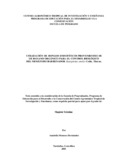Mostrar el registro sencillo del ítem
Utilization of endophitic fungy originated from organic banana plantations for the biological control of the burrowing nematode Radopholus similis Cobb. Thorne
| dc.contributor.advisor | Pocasangre, Luis E | |
| dc.contributor.author | Meneses Hernández, Anabella | |
| dc.date.accessioned | 2014-10-20T05:47:24Z | |
| dc.date.available | 2014-10-20T05:47:24Z | |
| dc.date.issued | 2003 | es_ES |
| dc.identifier | 365848 | es_ES |
| dc.identifier.uri | https://repositorio.catie.ac.cr/handle/11554/5634 | |
| dc.description | Tesis (M. Sc) -- CATIE, Turrialba (Costa Rica), 2003 | es_ES |
| dc.description.abstract | La diversidad de hongos endofíticos y la abundancia de nemátodos (Radophulus similis (R), Heliocotylenchus spp. (H), Meloidogyne spp. (M), Pratylenchus spp. y nemátodos de vida libre) en banano (BanCon) y plátano (PICon) convencionales fue comparado con banano orgánico (banano en monocultivo (B), banano con cacao (B+C), banano con cacao y especies forestales (B+C+F) y banano con especies forestales (B+F). Se evaluó la actividad antagonista de los aislados de Fusarium y Trichoderma provenientes de las parcelas con más diversidad de hongos endofíticos y menor población de nemátodos. El tratamiento P3 del género Fusarium, además de presentar mayor efecto de biocontrol contra R. similis, tuvo mayor efecto en promoción de crecimiento, donde los valores encontrados para altura y peso del sistema foliar, y el número y peso de raíces, fueron 12, 18; 9,39; 26,02 y 11,22 por ciento mayores que los valores promedio del resto de tratamientos. Diversity of endophytic fungi and nematode abundance (Radophulus similis (R), Helicotylenchus spp. (H), Meloidogyne spp. (M), Pratylenchus spp. and free living nematodes) in conventional banana (Bancon) and plantain (PICon) was compared with organic banana (monoculture banana-B-), banana with cacao (B+C), banana with cacao and timber species (B+C+F), banana with timber species (B+F). The antagonistic activity of isolates belonging to Fusarium and Trichoderma that were coming from the plots with more diversity of endophytic fungi and less population of nematodes, was evaluated. The P3 treatment of the genus Fusarium, presented the highest values in promotion growth, where the values found for height and weight of the stem, the number and weight of roots, were 12,18; 9,39; 26,02 and 11.22 percent greater than the average values of the rest of treatments. | es_ES |
| dc.language.iso | es | es_ES |
| dc.publisher | Centro Agronómico Tropical de Investigación y Enseñanza (CATIE) | es_ES |
| dc.subject | COSTA RICAMUSA (BANANOS) | |
| dc.subject | MUSA (PLATANOS) | |
| dc.subject | RADOPHOLUS SIMILIS | |
| dc.subject | TRICHODERMA FUSARIUM | |
| dc.subject | AGENTES DE CONTROL BIOLOGICO | |
| dc.subject | HELICOTYLENCHUS MELOIDOGYNE | |
| dc.subject | PRATYLENCHUS NEMATODA | |
| dc.subject | AGRICULTURA ORGANICA | |
| dc.subject | AGROFORESTERIA | |
| dc.subject | SISTEMAS DE EXPLOTACION | |
| dc.subject | HONGOS | |
| dc.subject | ANTAGONISMO | |
| dc.subject | PARASITISMO | |
| dc.subject | MECANISMOS DE DEFENSA | |
| dc.subject | CONTROL BIOLOGICO | |
| dc.title | Utilization of endophitic fungy originated from organic banana plantations for the biological control of the burrowing nematode Radopholus similis Cobb. Thorne | es_ES |
| dc.title.alternative | Utilización de hongos endofíticos provenientes de banano orgánico para el control biológico del nemátodo barrenador Radopholus similis (Cobb) Thorne | es_ES |
| dc.type | Tesis de maestría | es_ES |
| dcterms.rights | acceso abierto | es_Es |
| dc.identifier.publication | Turrialba (Costa Rica) | es_ES |
Ficheros en el ítem
Este ítem aparece en la(s) siguiente(s) colección(ones)
-
Tesis [3111]


